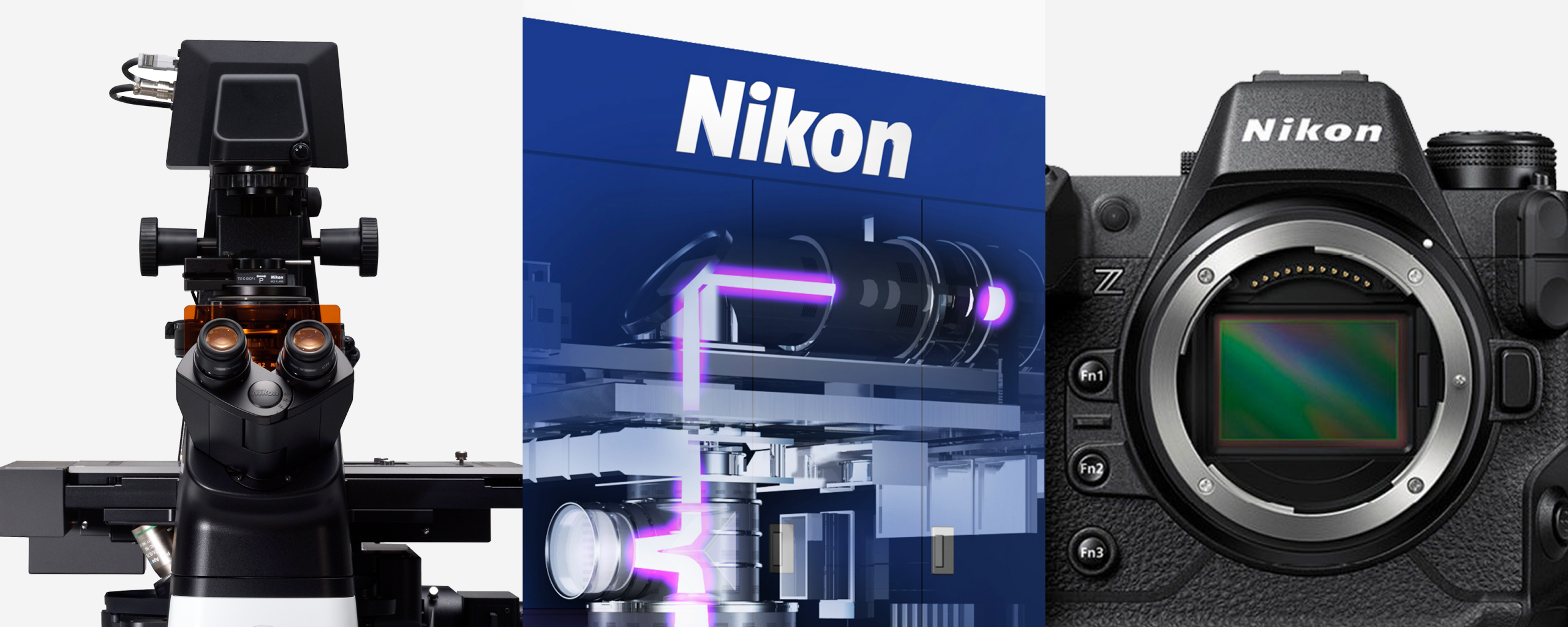Intellectual Property Initiatives

Protecting Products and Services with a Strategic Mix of Intellectual Property: Patents, Designs, and Trademarks to Enhance Nikon's Corporate Value
Intellectual Property Strategies
Nikon develops and implements an "intellectual property strategy" for each business to support the "business strategy" crafted by each division. This helps achieve management plans from an intellectual property perspective. Through this approach, we aim to utilize an intellectual property mix that combines patents, designs, and trademarks to comprehensively protect products and services. In formulating and implementing the "intellectual property strategy," business units, R&D divisions, and the intellectual property division work closely to promote the creation of intellectual property and risk management, which are essential for business growth from a medium- to long-term perspective.
Creation and Utilization of Intellectual Property
To adequately protect the competitiveness of products and technologies that support sustainable business growth, Nikon has established and effectively utilizes a necessary and sufficient intellectual property portfolio. We respect others' intellectual property rights while taking a resolute stance against infringements of our own intellectual property rights.
Details of Major Activities
Nikon actively protects advanced fundamental technologies created through research and development activities. We also protect technologies, designs, and trademarks related to various products through intellectual property rights. This approach ensures that Nikon continuously enhances competitiveness with an eye on the future.
Patents
In each business area, Nikon actively engages in "patent creation activities," through which it identifies core technologies that are the source of market competitiveness, promptly files patent applications, and builds a unique patent portfolio. In the patent creation activities, business departments, development departments, and intellectual property departments work together according to business and technology development strategies. They promote activities from theme decision to patent portfolio building.
Click to enlarge
At the "Theme decision" stage, "key themes" are decided based on the perspective of identifying what attractive products and services will meet future customer needs and what new functions and technologies are essential to realize them.
In the next stage, “Invention harvesting” development and intellectual property personnel form a team to concretely clarify advanced core technologies essential for new functions and technologies.
At the subsequent “Application” stage, we strategically file patent applications while paying attention to the protection of know-how, and then we build a patent portfolio that supports technological advancement. Through our patent creation activities, we enhance Nikon's market competitiveness, which contributes to Nikon's management plans and supports sustainable growth and improvement of corporate value from the perspective of intellectual property.
Design Patents
We strive to create unique designs that differentiate our products from those of other companies and prevent imitations. We have built a comprehensive design patent portfolio by extracting all relevant elements from designs created and filing applications for design registration both domestically and internationally. We take into account the characteristics of our designs and aim to protect design patents that have not only aesthetic appeal but also functional and brand formation value. In particular, we increase the competitiveness of our products by identifying designs with high usability and superior operability and functionality and by protecting product and image designs with design patents. Furthermore, to provide an environment where customers can purchase with peace of mind, we are strengthening our monitoring of e-commerce sites and cracking down on the sale of counterfeit products based on our design patents. We will continue to work to protect and increase the value of the Nikon brand globally through our design patents strategy.
Trademarks
The Nikon brand has a history spanning over a century, and in order to protect its value around the world, the trademark “Nikon” has been registered in approximately 180 countries and regions, including emerging countries. “Nikon” is acknowledged and established as a beloved brand around the world. Particularly, in Japan, China, Turkey, Russia, Taiwan, and the Philippines, its popularity is recognized by the trademark systems of each country, and it receives strong protection known as a well-known trademark.
Regarding names of products and services developed under the Nikon brand, we conduct research based on the business units’ product strategies and apply for and obtain trademark rights, playing an important role in determining names. In addition, by collaborating globally with domestic and overseas subsidiaries, which have newly joined the Nikon Group through M&A, we ensure to maximize the Nikon brand value for product sales and customer acquisition and to secure usability of trademarks.
We take strict measures against counterfeit and infringing products, such as taking down e-commerce sites, implementing border controls in cooperation with the customs authorities of each country, and conducting raids on sales outlets and manufacturing plants in China. Furthermore, we take strict action against illegal parallel imports in Europe, creating safe environments for customers to purchase products. We will continue to actively utilize trademark rights and do our best to protect the Nikon brand and to earn trust from our customers.
Training
To disseminate our intellectual property strategy and improve its effectiveness, we have built an educational program that contributes to improving company-wide intellectual property literacy.
Company-wide education: Develop and implement educational content tailored to each role to improve IP literacy across the Nikon group.
Specialized education within the intellectual property department: Provide necessary education and training taking into account with individual aptitudes and desires. (E.g., OJT, external training, exchange with other companies, overseas training)

